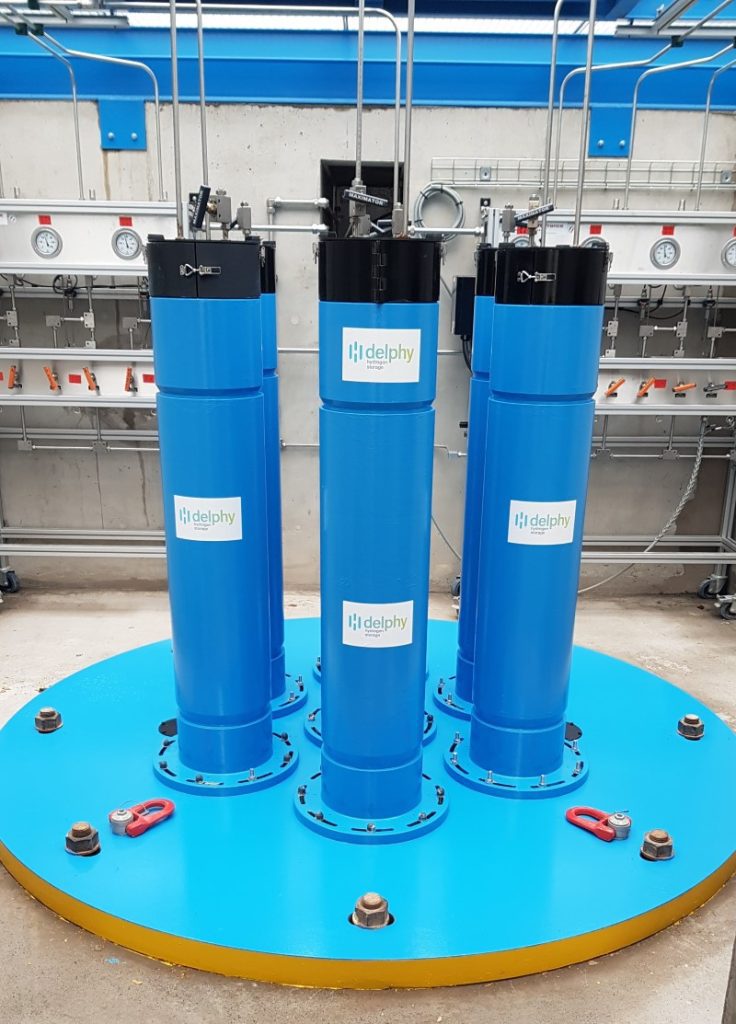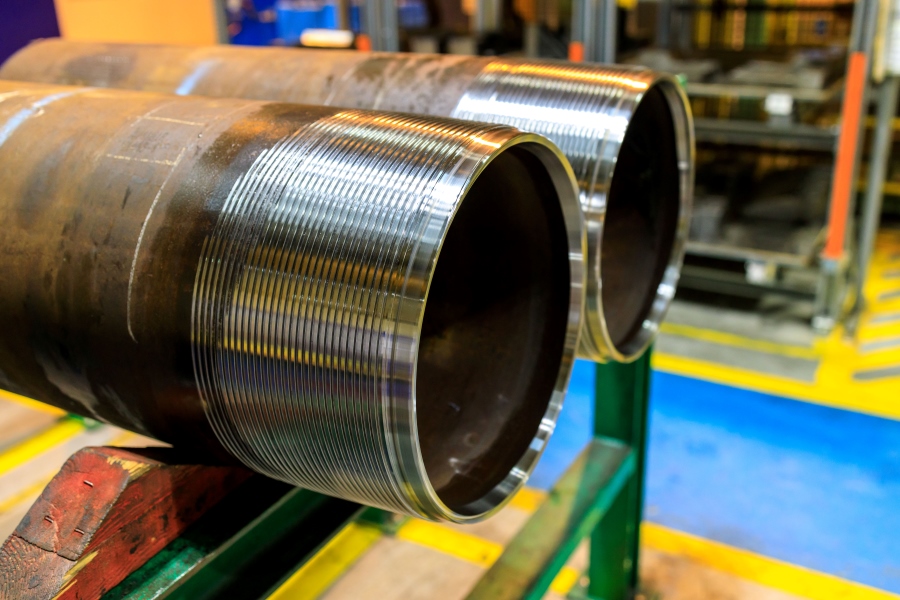Growing demand for hydrogen storage
Hydrogen will have a significant role to play in meeting global emissions reduction targets, and the shift from grey to green hydrogen is gaining pace. After 2025, nearly all new hydrogen production coming online is expected to be clean hydrogen.¹
The demand for green hydrogen production and supply is thus growing around the world. In Europe, the REPowerEU initiative targets the production of 10 million metric tons of green hydrogen by 2030.² In the United States, the Inflation Reduction Act has committed to funding seven new regional clean hydrogen hubs.³
With hydrogen high on the global energy agenda, the industry needs safe and efficient storage solutions at every step of the value chain. Upstream, the production of green hydrogen comes with inevitable challenges related to the intermittence of renewable energy used to power electrolysis. Electricity availability and price can fluctuate drastically. To overcome issues due to variability, producers can store hydrogen to optimize their electricity mix and thus improve the competitiveness of hydrogen production, or at least offer stable output.
Midstream, hydrogen storage can be required in the transport and distribution phases to meet demands for heavy mobility, for example. At hydrogen refueling stations, buffer storage is needed to ensure the availability of compressed hydrogen for refueling and to adapt to variations in refueling demand.
Downstream, end users in industries such as shipping, steelmaking, and ammonia production require a reliable supply of hydrogen. For an ammonia producer, for instance, halting production due to an insufficient hydrogen supply is unthinkable. It would result in a significant cost impact and could take hours, if not days, to restart production. A buffer stream of hydrogen is essential to meet peaks and valleys in production.
The need to balance intermittent production with steady supply therefore demands significant hydrogen storage capacity.
Specific challenges for hydrogen storage
Several challenges create barriers to implementing hydrogen storage infrastructure. Safety is top of mind.
Hydrogen is a difficult gas to contain, with a high propensity to leak. It can also affect steel materials – a phenomenon known as hydrogen embrittlement, whereby the absorbed hydrogen reduces metal ductility and results in cracking. This calls for appropriate metallurgies and tight systems.
Hydrogen is also a highly flammable and explosive gas, leading to concerns about storage safety. The European Union, UK, and many other countries have very stringent safety regulations in place for hydrogen storage. The EU SEVESO directive, for instance, starts at 5 metric tons of hydrogen storage. With this in mind, safety and compliance are top priorities for hydrogen producers and users.
In addition to safety, permitting is an important consideration. Current hydrogen storage solutions are cumbersome and require vast amounts of space. Overground cylinder racks quickly become impractical when storing several metric tons of hydrogen due to their size. Depending on the location, acceptance from the surrounding community can be a challenge when installing unsightly cylinder racks. What’s more, as highlighted by the International Energy Agency, this type of large civil engineering project often spans several jurisdictions, which can lead to delays due to permitting issues and a lack of socio-political support.⁴
The alternative – geological storage – relies on suitable geology in proximity, such as salt caverns or depleted gas reservoirs. Even when this is an option, geological storage solutions can require between five and seven years for construction. They also depend on the availability of the pipeline grid and sufficient production and demand, in thousands of tons of hydrogen. Onsite storage close to the point of production or use will therefore be needed.
To optimize space, hydrogen gas can be liquefied. While the density of hydrogen gas is approximately 0.083 g/L at atmospheric pressure, in the same conditions, liquefied hydrogen is 71.1 g/L, meaning it is about 853 times denser in liquid form.⁵ Yet, vast amounts of energy are lost in the liquefaction process – around 25–35%.⁶ If liquid hydrogen is required in the supply chain, this is an appropriate solution, but otherwise, liquefaction is a costly and energy-intensive approach.
Unique underground solution
Vertical hydrogen storage housed below ground presents a new storage solution for quantities of hydrogen ranging from 1 to 100 metric tons. In such a system, hydrogen is pressurized and injected into long pressure vessels made of pipe assemblies. Each pipe is 12 meters long, and, depending on needs, varying numbers of pipes can be assembled using threaded connections to reach the desired depth. These pipe strings are inserted into excavated ground between 5 and 10 meters in diameter and up to 100 meters in depth.
Significantly lower footprint
One of the principal concerns that an underground vertical storage solution addresses is the footprint required for hydrogen storage. Using a vertical underground system can occupy up to 30 times less surface area than alternative above-surface solutions. It utilizes existing underground civil works technologies, such as ventilation shafts and access wells, and applies existing knowledge from the energy sector for the assembly of steel pipes.
Housed below ground, the storage system is nearly invisible – helping with acceptance from surrounding communities and meeting permitting requirements. The vertical solution also means hydrogen is much less exposed, improving security by limiting access.
You are currently viewing a placeholder content from YouTube. To access the actual content, click the button below. Please note that doing so will share data with third-party providers.
More InformationThis system can store up to 100 metric tons of hydrogen underground, occupying up to 30 times less surface area than alternative above-surface solutions.
Optimal safety
Vertical storage brings numerous gains in terms of safety. Firstly, the cavity is inert. With no oxygen in the space between pipes, it prohibits the potential for an explosion, minimizing risk in the underground part of the storage. The solution also provides passive ventilation. In the unlikely event of a leak, hydrogen is unable to accumulate. It would dissipate and rise to the surface, where it would be detected, and the leak would be quickly dealt with. In the theoretical event of an explosion, energy would be directed upwards, away from equipment and personnel onsite.
On top of this, the storage system is equipped with rigorous safety features. Drawing on state-of-the-art instrumentation and automation, the solution provides optimal leak detection, fire detection, and fire safety. Piping and instrumentation are connected in the upper part of the assembly in an accessible chamber, as is the automation that controls the system – including leak detection and sensing methods, infrared and hydrogen sensors.
The materials selected have been explicitly engineered and validated for hydrogen applications. This includes qualified hydrogen-resistant tubes and hydrogen-tight connections to ensure a metal-to-metal seal, withstand hydrogen-induced embrittlement, and prevent any potential leaks. By using specialized materials, the secure, long-term storage of hydrogen is ensured, especially under demanding conditions like frequent cycling.
Modular, customizable solution
This new storage solution is also modular, designed to respond to a broad range of storage capacity demands. Capacity can range from 1 to 100 metric tons, and storage can be customized to the specificities of the hydrogen storage requirement. Both capacity and pressure level can be adjusted as required, and the solution adapts to the onsite space available and optimal depth based on local soil conditions.
The system is also scalable. As demand for storage grows or decreases, tubes can be added or removed to adapt to the project’s evolution. This makes it a highly adaptable solution to maximize the efficient utilization of storage space.
Using modular and scalable vertical tube strings to store compressed hydrogen optimizes both operational expenditure (Opex) and capital expenditure (Capex). The initial investment is directly dependent on the required storage capacity but can be gradually increased over time. Upfront costs can thus be minimized, leaving the option to expand storage as time goes on.
Demonstrating the technology
To bring the solution to life, Vallourec built a fully functional demonstrator of its Delphy underground vertical storage system in Aulnoye-Aymeries, France. The demonstrator provides the opportunity to test the hydrogen storage technology firsthand, in a real-world setting. It operates at a small scale – with 150 kg of hydrogen – and is representative of all the main functions and steps in the value chain.
Various tests are currently being conducted at the site as part of a technology qualification program developed according to DNV-recommended practices for the qualification of innovative technology. Vallourec is also undergoing the approval program for the equipment to comply with the EU Pressure Equipment Directive (PED) and the American Society of Mechanical Engineers (ASME) code in the United States.
Adapting tubular vessels to the specificities of hydrogen
To design such safe and long-lasting storage systems, Vallourec calls upon its core areas of expertise.
A major risk is the hydrogen embrittlement of metal pipes, which can put at risk the structural integrity of equipment and infrastructure. This is a phenomenon that Vallourec’s teams have studied for a long time. In particular, they have explored the development of suitable products for resistance to sour corrosion driven by hydrogen sulfide (H₂S), a strong promoter of hydrogen absorption in metal.
By drawing on existing knowledge of material resistance and sour corrosion resistance, the best alloys were chosen to resist hydrogen embrittlement. This experience and the corresponding product portfolio were leveraged to conduct a research program dedicated to dihydrogen (H₂) service, including fracture toughness (FT) and fatigue crack growth rate (FCGR) experimental tests.⁷ Combined with Vallourec’s deep expertise of metallurgies (chemistry, microstructure, mechanical properties), this experience informed the selection and validation of appropriate material for use in hydrogen storage vessels. Notably, the proprietary steel grade VM110SS was chosen, designed for sour service and resistant to high corrosion.
Tests in Aulnoye-Aymeries were initiated with a mixture of hydrogen and nitrogen before progressing to pure hydrogen. Pressure was held at 280 bar for several months to ensure meticulous measuring of potential leakage and to ensure that containment tubes were safe and fully hydrogen-tight. Once tests were able to rule out leakage, various additional tests were subsequently launched and are still ongoing. They include pressure cycles, filling and emptying conditions, maintenance and re-testing conditions (including an onsite hydrotest), emergency shutdown scenarios, etc.
This program will run until Q3 2024. It provides evidence of the high safety performance of the system and is instrumental in the validation of this new technology.
Similarly, Delphy technology relies heavily on the ability to tightly connect pipes to each other, using unique premium mechanical connections. While conventional – and extensive – leak test programs have been conducted with helium as the leak tracer, Vallourec concluded that tests with hydrogen gas were needed to ensure hydrogen tightness.
The teams pioneered a fit-for-purpose testing program. The test program was performed in full-scale in 9–5/8” 47.00 ppf L80 on Vallourec’s latest generation of advanced premium connections. It covered pressure and temperature cycles as well as mechanical loads (tension, compression) to represent the conditions expected in operations. Lab tests were complemented by simulation by finite element analysis to expand the results to cover other configurations that are less critical in terms of tightness. Overall, the assessment of hydrogen sealability performance showed very positive results, which made it possible to employ this technology for the Delphy hydrogen storage system. Test results from the demonstrator confirm the excellent tightness in operation.
In terms of size, 10 ¾-inch tubes were used, with a target of higher ranges, from 14 to 16 inches, for industrial-scale implementation of Delphy. Field service teams assembled the tubes with a power tong, with careful monitoring of the torque – supervised by our field service specialists – to confirm safe installation of the connection and perfect tightness.
The future for vertical hydrogen storage
Beyond its own demonstrator, Vallourec is actively preparing the first industrial projects and receiving positive feedback from customers and prospective partners. This has been recently highlighted with the announcement of two collaboration agreements for vertical hydrogen storage between Vallourec – using its Delphy technology – and, respectively, H2V and NextChem Tech.
H2V is developing large-scale green hydrogen production in France and Europe. The collaboration includes an investigation into the potential integration of the vertical storage solution with green hydrogen production and use projects developed by H2V at Marseille Fos port, France. The goal is to enable H2V to streamline costs and offer high supply safety levels, as well as to implement a more flexible supply system and adapt to electricity supply constraints.
The second partnership, with NextChem Tech, is aimed at introducing vertical storage into green hydrogen and green ammonia projects. The collaboration will focus on synergies between world-leading green ammonia production technologies and high-capacity hydrogen storage.
Both partnerships bear testament to the demand for alternative hydrogen storage solutions to tackle challenges in the intermittent production of green hydrogen and ensure a reliable supply. The vertical hydrogen storage solution responds to a gap in the market for mid-range hydrogen quantities that need to be stored in a way that optimizes space and maximizes safety. It balances new innovations with established technologies to enable modular and customizable hydrogen storage and holds the potential to revolutionize the future of hydrogen storage.
References
¹ McKinsey & Company. (2024). Global Energy Perspective 2023: Hydrogen outlook.
² European Commission. (2023). Hydrogen.
⁴ IEA. (2023). Global Hydrogen Review 2023.
⁵ GenH2. (2022). Defining the Hydrogen Economy from A to Z: D is for Density.
⁶ IRENA. (2022). Geopolitics of the Energy Transformation: The Hydrogen Factor.
About the author

Vincent spent nine years working with the French Ministries of Economy and Environment in several roles, notably related to safety and environmental transformation. In 2017, he joined Vallourec as Strategy Director before being appointed Hydrogen Director in 2020, where he developed Vallourec’s business in the hydrogen markets with a strong focus on hydrogen storage. Since 2023, Vincent and his team have been building the first demonstrator and leading the technological and commercial development of Delphy, Vallourec’s revolutionary underground hydrogen storage solution. Vincent was named Delphy Director in May 2024.





